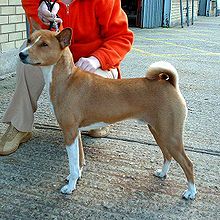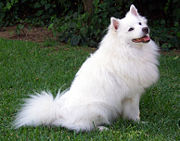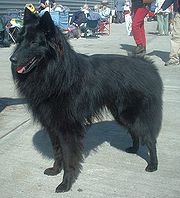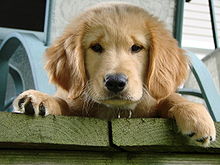- Canine terminology
-
Canine terminology in this article refers only to dog terminology, specialized terms describing the characteristics of various external parts of the domestic dog, as well as terms for structure, movement, and temperament. This terminology is not typically used for any of the wild species or subspecies of wild wolves, foxes, coyotes, dholes, jackals or the basal caninae. Dog terminology is often specific to each breed or type of dog. Breed standards use this terminology in the description of the ideal external appearance of each breed, although similar characteristics may be described with different terms in different breeds.
Contents
Dog coats
Main article: Coat (dog)Dogs diverged from a now-extinct Asian wolf between 12,000 and 15,000 years ago, according to recent DNA studies. In that time, the long nose and heavy grey-colored double coat of the wolf has changed into the wide variety of dog shapes and coats and colors seen today. The change was due at first to genetic changes that occurred as the original dogs learned to tolerate the presence of humans, as shown in the research on foxes by Dmitri Belyaev in his Farm-Fox Experiment. The research found that a genetic change to tameness brought along other unexpected changes as well; one notable change was in the coats, changed from a typical fox coat to a spotted coat resembling a dog's coat. As ancient dogs learned to live near humans and became less like wolves, their appearance changed as well, long before any selective breeding was done by people.[1]
A Stanford University School of Medicine study published in Science in October, 2007 found the genetics that explain coat colors in other mammals such as in horse coats and in cat coats, did not apply to dogs.[2] The project took samples from 38 different breeds to find the gene (a beta defensin gene) responsible for dog coat color. One version produces yellow dogs, and a mutation produces black. All dog coat colors are modifications of black or yellow.[3] For example, the white in white miniature schnauzers is a cream color, not albinism (a genotype of e/e at MC1R.)
Today, dogs exhibit a diverse array of fur coats, including dogs without fur, such as the Mexican Hairless Dog. Dog coats vary in texture, color, and markings, and a specialized vocabulary has evolved to describe each characteristic.[4]
Color
One often refers to a specific dog first by coat color rather than by breed; for example, "a blue merle Aussie" or "a chocolate Lab". Coat colors include:
- Black
- Brown: From mahogany through liver (dark brown).
- Red: Reminiscent of reddish woods such as cherry or mahogany; also tawny, chestnut, orange, rusty, and red-gold.
- Yellow: From pale cream to a deep yellowish-gold tan.
- Gold: From pale apricot to rich reddish-yellow.
- Gray: Pale to dark gray, including silver; can be mixed with other colors or various shades to create sandy pepper, pepper, grizzle, blue-black gray, or silver-fawn.
- Blue: A dark metallic gray, otherwise known as slate; diluted black pigment. Blue merle is genetically black, not blue.
- Sable: Black-tipped hairs; the background color can be gold, silver, gray, or tan.
- White: Distinct from albino dogs.
Pattern
 The Dalmatian's coat is one of the more widely recognized markings.
The Dalmatian's coat is one of the more widely recognized markings.
Coat patterns include:
- Two-color coats: such as Black and tan, red and white. The coat has both colors but in clearly defined and separated areas; usually the top and sides are darker and lower legs and underside are the lighter color.
- Tricolor: Consisting of three colors, usually black, tan, and white or liver, tan, and white.
- Brindle: A mixture of black with brown, tan, or gold, usually in a "tiger stripe" pattern.
- Harlequin: "Torn" patches of black on white.
- Merle: Marbled coat with darker patches and spots of the specified color.
- Particolor: Two-colored coat with the colors appearing in patches in roughly equal quantities.
- Tuxedo: Solid (usually black) with a white patch (shirt front) on the chest, and white on some or all of the feet (spats.) This pattern is sometimes called Irish Spotting, Flashy, or Boston.
Texture
Coat textures vary tremendously. Some coats make the dogs more cuddly and others make them impervious to cold water. Densely furred breeds such as most sled dogs and Spitz types can have up to 600 hairs per inch, while fine-haired breeds such as the Yorkshire Terrier can have as few as 100, and the "hairless" breeds such as the Mexican Hairless Dog and the Peruvian Inca Orchid have none on parts of their bodies. The texture of the coat often depends on the distribution and the length of the two parts of a dog's coat, its thick, warm undercoat (or down) and its rougher, somewhat weather-resistant outer coat (topcoat, also referred to as guard hairs). Breeds with soft coats often have more or longer undercoat hairs than guard hairs; rough-textured coats often have more or longer guard hairs. Textures include:
 The German Wirehaired Pointer's coat demonstrates a rough texture.
The German Wirehaired Pointer's coat demonstrates a rough texture.
- Double-coated: Having a thick, warm, short undercoat (or down) that is usually dense enough to resist penetration by water and a stronger, rougher weather-resistant outer coat (topcoat), also referred to as guard hairs. Most other coat types are also double-coated.
- Single-coated: Lacking an undercoat.
- Smooth-coated: "Smooth" to the eye and touch.
- Wire-haired: Also called broken-coated. The harsh outer guard hairs are prominent, providing excellent weather protection for hunting dogs such as the Border Terrier or Wirehaired Pointing Griffon.
- Long-haired: Hair longer than an inch or so.
- Short-haired: Hair around an inch or so long.
- Corded coat: for example, see Puli
Parts of the body
A special vocabulary has been developed to describe the characteristics of various body parts of the dog. Terms are often specific to each breed or type of dog.
Head
The parts of the head are the nose, muzzle, stop, forehead or braincase, occiput (highest point of the skull at the back of the head), ears, eyes, eyebrows or brows, whiskers, flews (lips, which may hang down), and cheeks.
Dog heads are of three basic shapes:[5]
- Apple-headed refers to a dog's head that is round on top, not flat.
- Brachycephalic, or shortened muzzled, sometimes so short that it can lead to breathing problems, such as in the Pug.
- Dish-faced refers to a dog whose nasal bone is higher at the nose than at the stop.
- Dolichocephalic, or long and narrow, as seen in most "hounds" like a Borzoi or other breeds such as the Rough Collie and the Grey Wolf.
- Down-Faced, a convex facial structure where the muzzle is turned slightly downward when looked at from the dogs profile, such as a Bull Terrier.
- Mesocephalic, or wedge shaped (broad skull with a narrower muzzle).
Nose
- Butterfly Nose is of two colors.
- Dudley Nose is a flesh-colored nose.
Muzzle
A snipey muzzle is one that is too pointed for good breed type.
Stop
The stop is the degree of angle change between the skull and the nasal bone near the eyes.
Forehead or braincase
Occiput
The occiput is very noticeable on a Bloodhound. The back of the head.
Ears
 The Basset Hound's ears are extremely long drop ears.
The Basset Hound's ears are extremely long drop ears.
Dogs' ears come in a variety of sizes, shapes, lengths, positions on the head, and amounts and types of droop. Every variation has a term, including:
- Bat ear: Erect, broad next to the head and rounded at the tip, such as the ears on a Chihuahua.
- Button ear: A smaller ear where the tip folds forward nearly to the skull, forming a V, as in the Jack Russell Terrier.
- Cropped ear: Shaped by cutting; see docking.
- Drop ear: An ear that folds and droops close to the head, such as most scent hounds'and the little known Blue Lacy. Also called a pendant ear.
- Natural: Like a wolf's.
- Prick ear: Erect and pointed; also called pricked or erect.
- Rose ear: A very small drop ear that folds back; as in the greyhound or bulldog.
- Semiprick ear: A prick ear where the tip just begins to fold forward, as in the Rough Collie.
- Hound ear: A floppy ear that is long and droopy. It is common to all hound-type breeds as in the Beagle, Basset Hound, Bloodhound and Foxhound.
Eyes
There has been a myth going around for many years that dogs can only see in black and white. A dog's vision is actually equivalent to a human with red-green color blindness. Different breeds have different shapes of eyes. It all depends on the purpose. If a dog is a hunter, they most definitely need good eyesight. Therefore those breeds have a wider range of vision than others. As a rule of thumb, breeds with short heads have a narrower field of vision, whereas breeds with longer heads have a wider field of vision - such as wolf, sighthound.
Eyebrows or brows
Whiskers
Flews
Pendulous lips may be called chops.
Cheeks
Cheeky refers to a dog with strongly defined cheeks.
Mouth and Teeth
Bite describes how the dog's teeth meet when its mouth is closed.
Body
The body may be described as "cobby" (short and square) or sometimes by a ratio of height to length.
Withers
Skin
Legs and gait
Feet
One way a dog releases heat from its body is from in between its paws.
Tails
 The Basenji's tail is tightly curled.
The Basenji's tail is tightly curled.
Like ears, tails come in a tremendous variety of shapes, lengths, amounts of fur, and tailsets (positions). Among them:
- Bob: Short or non-existent tail, such as an Australian Shepherd or Pembroke Welsh Corgi.
- Corkscrew: Short and twisted, such as a Pug's
- Docked: Shortened by surgery or other method, usually two or three days after birth; see docking
- Odd: Twisted, but not short. Uncommon. Tibetan Terriers have odd tails.
- Saber: Carried in a slight curve like a saber
- Sickle: Carried out and up in a semicircle like a sickle
- Squirrel: Carried high and towards the head, often with the tip curving even further towards the head.
- Wheel: Carried up and over the back in a broad curve, resembling a wheel.
See also
References
- ^ Trut, Lyudmila N (1999). "Early Canid Domestication: The Farm-Fox Experiment". American Scientist 87 (2): 160–9. http://www.floridalupine.org/publications/PDF/trut-fox-study.pdf. (A Russian study of pedomorphosis in a 40-year breeding program to domesticate red foxes.)
- ^ Candille SI, Kaelin CB, Cattanach BM, et al. (Nov 2007). "A -defensin mutation causes black coat color in domestic dogs". Science 318 (5855): 1418–23. doi:10.1126/science.1147880. PMC 2906624. PMID 17947548. http://www.pubmedcentral.nih.gov/articlerender.fcgi?tool=pmcentrez&artid=2906624.
- ^ Stanford University Medical Center, Greg Barsh et al. (2007, October 31). Genetics Of Coat Color In Dogs May Help Explain Human Stress And Weight. ScienceDaily. Retrieved September 29, 2008
- ^ "Genetics of Coat Color and Type in Dogs". Sheila M. Schmutz, Ph.D., Professor, University of Saskatchewan. October 25, 2008. http://homepage.usask.ca/~schmutz/dogcolors.html. Retrieved 11/05 2008.
- ^ Margaret H. Bonham (2006). Dog Grooming For Dummiesʾ. New York: John Wiley & Sons, Inc. p. 27. ISBN 0-471-77390-5.
- The Boston Terrier And All About It by Edward Axtell, Chapter XV. Technical Terms Used In Relation To The Boston Terrier, And Their Meaning. Publisher: Vintage Dog Books, 2006, ISBN 1846640628
- Spira, Harold R. (1982). Canine terminology. San Francisco: Harper & Row. ISBN 0-06-312047-X.
External links
Dogs Training Behavior Health Types List of types · Bandogs · Eskimo dogs · Companion dog · Curs · Fighting dogs · Guard dogs · Herding dogs · Hounds · Hunting dogs · Bird dogs · Gun dogs · Lap dogs · Livestock guardian dogs · Mountain dog · Pointers · Retrievers · Setters · Primitive dogs · Scenthounds · Sighthounds · Sled dogs · Terriers · Turnspit dogs · Water dogsBreeds Work Human–dog
interactionAnimal testing · Baiting · Breed-specific legislation · Communication · Dog park · Dog sports · Dog walking · Dog daycare · Dog grooming · Intelligence · Therapy · Training · Fear of dogs · Dog license · Dog food · Dogs in religionCategory · Portal · BookCategories:- Dog anatomy
- Dog shows and showing
Wikimedia Foundation. 2010.



